By Dan Shea
1 August, 2007, Dayton, NV
David Edward “Dangerous Dave” Cumberland was born 18 November, 1932 in Fairley Farm, Virginia. He married his wife Elsie in 1955. Dave was Interarmco’s man in Thailand in the 1950s and one of the early machine gun and cannon dealers in the US. His company, The Old Western Scrounger, was renowned for helping shooters around the world get their odd ammunition needs filled. This author has known Dave for thirty years and we caught up with Dave at his home in Nevada, where he was pleased to sit down and recap many of his experiences for SAR’s readers. A lot of Dave’s experiences interact with a number of our other Interviews, and help “Fill in the blanks.” – Dan
SAR: When was the first time you were around firearms?
Dave: Right about the end of the Second World War, and that was just a 22 rifle. It was Mossberg 42MB, which was the last thing that Mossberg was making that the public could buy: they gave their all to the military. It was the only Mossberg rifle you could get around the end of the war. We went out plinking and hunting with it, go out to the dump and shoot rats. I lived in a small village in rural Virginia so that was pretty much expected of young boys. My father had a C96 Mauser pistol with a massive stock, and he never shot the gun to amount to a hill of beans, and he never knew much about guns. He wasn’t a hunter or shooter really, but I was fascinated by that gun. I finally figured out how to get it apart and back together again. Must have been about 18 years old at that time. Later I’d purchased a Trap Door Springfield Carbine and, why I bought this next one, I don’t know, but I had a Remington Derringer, 41 Rimfire. There was no ammunition for that but I just had to have it, it was so interesting.
SAR: Did you have any experience with machine guns early on?
Dave: No, not a thing. Not cannons either. Didn’t really have any interest in them, oddly enough for where I ended up. However, I made my share of pipe bombs and a good time was had by all.
SAR: You joined the service in…
Dave: In 1952. I was 20 years old and turned 21 when I was in San Diego. I was an electronic technician in the United States Navy. Traveled across the Pacific; headed for the Korean War. The first ship I was on went to Yokosuka, Japan and that was when they just did normal fleet operations for six months. It turned out we were only there for about two months and we got word to pull hook and head for Haiphong, Vietnam. So my ship turned out to be the command ship for the evacuation of the refugees from the communists, and the French army from Hanoi and Haiphong in French Indo-China, what you guys call Vietnam. That was mid to late 1954. That was the largest civilian evacuation ever, hundreds of thousands of refugees: they called it “Operation Passage to Freedom.” We brought the guy who was the 100,000th refugee and his family down with us on our ships. We didn’t take anybody else on our ship; we were strictly a command ship. We brought he and his wife down, everybody else came on LSTs and supply ships and what have you. We also evacuated the Tachen Islands between Communist Mainland China and Taiwan. The Nationalist Forces were cornered there by the Chinese Communists and we moved them to Taiwan. I was in the Navy for four years. I checked out in San Diego with my wife and we went to visit my parents and her parents on the East Coast.
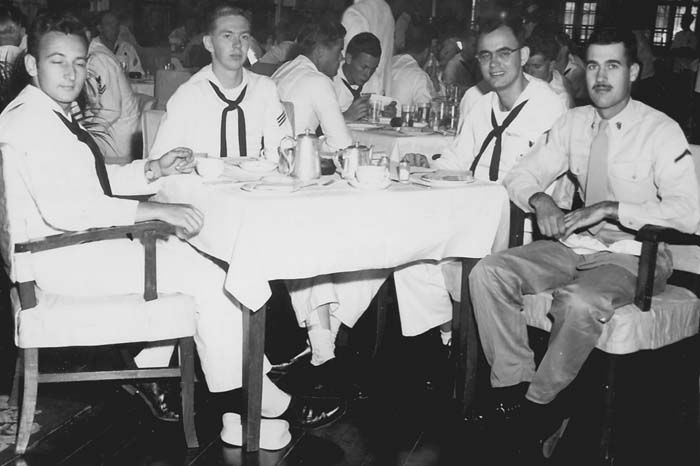
SAR: When did you go out for the nuclear tests?
Dave: That was before I got out and before the Indo-China refugees. I think it was in March of ’54. It was the second series of bomb tests on the hydrogen bomb and our ship had been in the first one called “Operation Ivy.” The second one, “Operation Castle” was the name of it. They’re available on videotape of all things. Our ship was the USS Estes. It was a communications force flag ship. It’s one big floating radio station that’s used to consolidate an amphibious landing, for example. Our sister ships were the USS Mount McKinley and the USS Mount Olympus. Mount McKinley was at Iwo Jima and the Mount Olympus was at D-Day in Normandy. We were all out in the Pacific, headed back to the states we thought. We had about 600 people on board and we took on food and supplies we needed for about four or five months and we sailed from the South Pacific. We got sidetracked to Bikini Atoll, which is where they hold the bomb tests, explaining why all the extra stores were needed.
SAR: So, on your way home, boys, why not stop off and watch the Nukes? (Laughter)
Dave: Yeah, that’s about it. Eniwetok Atoll is where they had all the scientific personnel and civilian engineers and stuff like that, plus they had an airfield there. It took us about ten days to get down there. It was just beautiful. There was a wrecked Japanese freighter on one of the little islands. That little island was also a recreation island for us, where you could go and swim. We’d go over there with an M1 Garand in. 30-06 so they could shoot sharks if they got after us. The first bomb test was supposed to be, I can’t remember exactly, but I think it was 15 or 16 megatons. They said it was less than 20 megatons, I do remember that. It turned out to be 40 megatons when the damn thing finally went off. It was unreal. We could see the shock wave coming along the water, approaching at the speed of sound, of course. I had a friend who was down in the engine room on watch at that time. He said that when the concussion hit the ship, it rocked the entire ship over. We could see that, ’cause we were up on the deck, which was pretty intense. He said it blew flame out of the boiler inspection ports ten feet all the way across the inside of the engine room. The back pressure from the shock wave back-flushed all the ventilation systems on the ship. That hadn’t been done since the ship was built in 1944, and you wouldn’t believe the piles of crap that came out of those ventilators all over the ship when that pressure wave hit us. Then we went to what was called a “Purple 2 alert,” which meant an atomic attack was in progress. We stayed there in general quarters for about 30 hours because you couldn’t go up on the flight deck, you couldn’t go topside because there was too much fallout. We had the sprinkler systems on all over the ship. That was also when the Japanese tuna fishing boat got caught in the fallout and it killed all the crew, it was the “Shot” called “Castle Bravo.” There’s no fresh water on those islands out there so, at the time this bomb was going off, they were bringing out tankers full of water to hose us down. The tanker got caught in the fallout, too, and they turned her around and sent her back to Ford Island in Pearl Harbor and dropped the hook out there. When we came back in several months later, she was still out there with atomic radiation signs all over the ship. It was pretty well toasted. They gave you a chance to do your part in all of this by spending time on the decontamination team. On the decon team you put a plastic suit on, and just imagine what the temperature’s like at about 100º outside. We’d get these plastic suits on and go out on the deck of a contaminated vessel and use a high-pressure steam hose, and do that for 20 minutes. Then you come back and wash off for ten minutes in fresh water, and present yourself to the guy with the Geiger counter. Put your hands up in the air, and he checks you everywhere for fallout. If he found anything, he took a little high-pressure hose and squirts the area down. For that, you got a free steak dinner that night. [laughter]
SAR: Have you experienced any problems from the fallout?
Dave: No. It’s interesting. When I first went to the Veterans’ Hospital in my old place up in Northern California, the first thing they asked me was if I was exposed to atomic radiation. I said, “Yes.” And they checked this little red block on the thing. I don’t think I have anything as a result of that Atomic testing, but I have Parkinson’s disease, and as a veteran, they pay for all of my Parkinson’s medicine.
SAR: In 1955 you were in San Diego. You signed out of the Navy, and then you took off to visit family.
Dave: Elsie and I bought a new Volkswagen Beetle for $1,500 and we drove that turkey across the country and back. We headed up to San Francisco and that’s where I went to work for the California National Guard on the 90mm batteries. The Bay Area in general had four batteries. It had two batteries of four guns each for anti-aircraft, using M-33 fire control radar. My job was to keep the radar and computer running. There were also two Nike missile defense situations in the same area. They were both on the hill to the north of the Golden Gate Bridge. I was there about a year and a half. I had to join the National Guard to get that job and when the time came for a new job, I went to Korea. I was teaching the U.S. Army how to keep their radar equipment in operating condition.
SAR: That was the post-Korean War era, while there was still a real tense situation on the demarcation line.
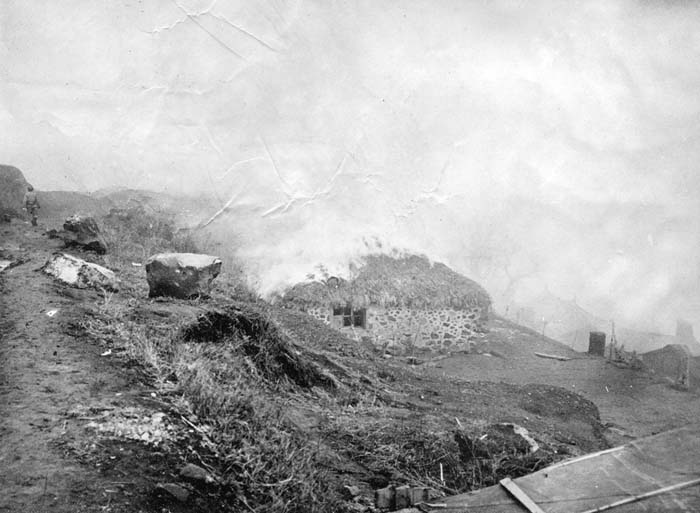
Dave: I have some pictures of me sitting with my feet up on the desk of the North Korean general’s negotiating chair in Panmunjom. I was shooting different weapons now. The Navy would allow us to shoot aboard ship “at the discretion of the Captain.” We used to shoot off of the fantail at a towed target. I had that Trap Door Springfield and a Broomhandle Mauser. That’s the first place I really got a chance to shoot a machine gun. I shot a 1918A2 BAR and a 1919A4 .30 caliber Browning from the ship’s armory. The 1919 was on a ship’s mount of course. To this day, machine guns don’t really turn me on that much. I like the big stuff. If I had a choice in a machine gun, it’d be a 3″ 50 automatic.
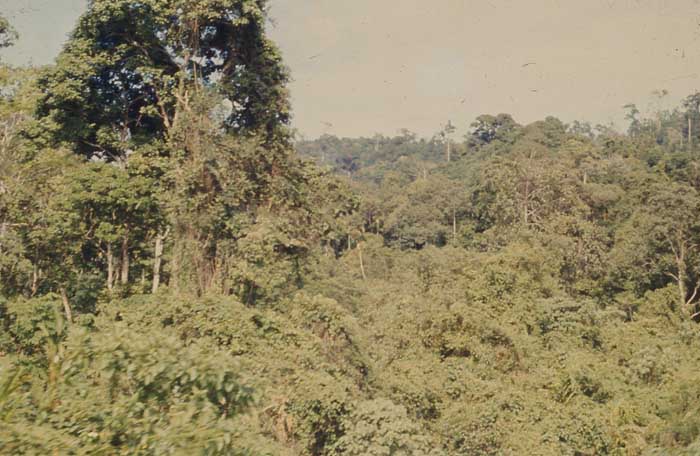
SAR: [laughs] Well, you have had a lot of machine guns, right?
Dave: Yes, I sure have. You asked what I like, and it’s always been the cannons that I’ve really enjoyed the most.
SAR: How long were you in South Korea for that job?
Dave: About 14 months. I was at the 7th Infantry Division in Seoul. They would give me a Jeep and say, “Go here. Go there,” to different places where they had repair facilities for radio equipment. I would go there and check out the systems and make sure the guys knew what the hell they were doing and that everybody was happy and that things worked the way they were supposed to. It was pretty good duty. When my time was up there, I came back to the United States and they wanted me to go out again. They said, “We only have two openings for you right now.” First was in Chile on top of a 13,000 foot mountain as part of the Vanguard tracking satellite system. I said, “No way in the world. It hasn’t rained down there in 30 years.” They gave up on that and said the other place was Bangkok, Thailand. Knowing a bit about Southeast Asia, I thought “That sounds a lot less bitter,” and I headed on over. That was 1958. Flew over this time, on a DC-7C Super Constellation, which went all of 265 miles an hour. Flew to Pearl Harbor, then to Wake Island, and on to Tachikawa Air Force Base in Japan. From there, I flew down to Manila and on to Bangkok. Of course, this was all MATS flights (Military Air Transport Service) so you took what you could get. A guy would go there with his orders and plead with the guy behind the counter to get on the quickest flight. It took a long time to travel, but you got there.
SAR: What was the situation when you got to Bangkok?
Dave: It was a little tense. It was not going full bore in Southeast Asia like it was two years later but, they had me in there going upcountry or down country and teaching the Thais how to keep their equipment running. While I was in a little place called Nakhon Si Thammarat in southern Thailand, I ran into a very wealthy Thai gentleman who owned a series of hock shops in Bangkok. There was a little Japanese airfield down there and there was a golf course. The greens were all fine sand. I used to play golf with him down there. He was a shooter, and he gave me an Eley cartridge display board that I sold two years ago for $8,000. He always had custom things – Holland & Holland made him a double size Swiss Army Knife. Interesting guy. We went hunting once together, for tigers, even though that was illegal. I shot one of those wild red bulls with an 1874 Sharps.
SAR: You went hunting on other trips around Thailand?
Dave: Oh yeah, many times. Got ambushed by Burmese bandits in the highlands once.
SAR: Dave, ambushed by Burmese bandits in the Thai highlands?
Dave: (Laughs) You heard me right. We were out in the middle of the jungle with a Thai hunter who was kind of interesting. He was just a plain old, everyday gentle person except his rifle was a Model 70 Super Grade, in .375 H&H. I couldn’t believe that. We had two elephants we rode, and the Thai fellow who was our hunter. He had his son along as a camp-watcher. We would go out and hunt all day and sit in the jungle at night and get bitten by mosquitoes. We slept in Jungle Hammocks, by the way, which I think is the only way to sleep in the jungle – up off the ground. This one evening about the third or fourth day we were there, we were sitting around the campfire. We had just finished eating, and I was smoking a cigar or cigarette. Jack and I were getting ready to turn in for the night. Some people came walking into the camp and we didn’t speak any Thai. We gave them tea, and we had a pound of Prince Albert tobacco. We gave them some Zig-Zag paper so they could roll smokes and have tea. They were talking with our guide. We had a Thai military phrase book and we finally got the idea that they were going to come back and kill us because we had too much stuff around that was just too saleable. Jack said, “My God, we’ve got to get out of here.” I said, “Wait a minute. Let’s find out what the old man wants to do. He lives here. He knows what’s going on. We don’t know where these people even are right now. They could be taking us in their sights right now.” He asked, “Well, what are you going to do?” I said, “I’m going to wait and see what the old man does.” The old man, he finally said something to the kid and the kid starts putting things together. He and the kid had been sleeping on the ground with the ants going over them, that didn’t make any difference to them. He cut some bushes and he put them into the two jungle hammocks. They were tied to one tree at one end and a tree here on the other end. Jack and I were in arm’s reach of each other pretty much. I had a 12 gauge. I took that and loaded that with buckshot. Jack had a Model 12 pump gun in 12 gauge and he put buckshot in that as well. We took up a counter-ambush position about 15 yards in the jungle. It was pretty thick right in there. At just a little after midnight, maybe an hour or two later, the old man reaches over and pokes me on the arm. He puts his cigarette in front of his lips and he points. You could see them in the moonlight, four of the five people that were in camp earlier. They had single-barreled shotguns when they were in camp before. Now they didn’t have the shotguns with them but they did have these big knives about two feet long. They each took up a position over one of the dummies that the kid had put together. I had these two guys right in front of me who thought they were going to hack us to death. Jack had another guy down on the end. The old hunter had the fellow in the middle. I only had two shots for two guys, and when that .375 went off next to me, I pulled the triggers and I got both of them, one with each shot. I shot them in the back as they started to hack what they thought was me, to death. Jack, who made it clear he didn’t want to shoot anybody, once it started he ended up hitting his guy about three times before he hit the ground. “Well,” he said, “this could be the end of my career.” I said, “It could have been the end of your life, you dummy. Good thing you did what you were told and followed this old man’s instructions.” The next morning, the old man and the boy stripped the bodies, put all their stuff on one elephant and put all of us on another elephant. He sent the one elephant back somewhere. I don’t know where he went, probably home. At about 3 o’clock in the afternoon, we were making another camp and here comes the elephant back with the kid on it. We hunted for another week and never saw anything to shoot except monkeys. I shot a monkey and we ate that just to taste it. It was tough as hell, but it was edible. It was much better while it was stew than it was when it was fried or anything else. If you had to eat it, you could. The kids there used to make Figure 4 traps. There were big lizards that lived in the ground. They weren’t monitors but they were pretty good sized. These lizards would come up and they’d stick their neck into this Figure 4 trap and choke to death. I’ve got that on film, pulling the stick out of the ground with the lizard thrashing away on one hand and me with the 8mm movie camera on the other hand. That was very good. We tried some kind of a great big hornet, as big as your little finger. The larva from these hornets were quite tasty. The hunter found one of these things and he fired up his pipe and he blew the smoke down the hole. We dug it up and we cooked them up and they were pretty good.
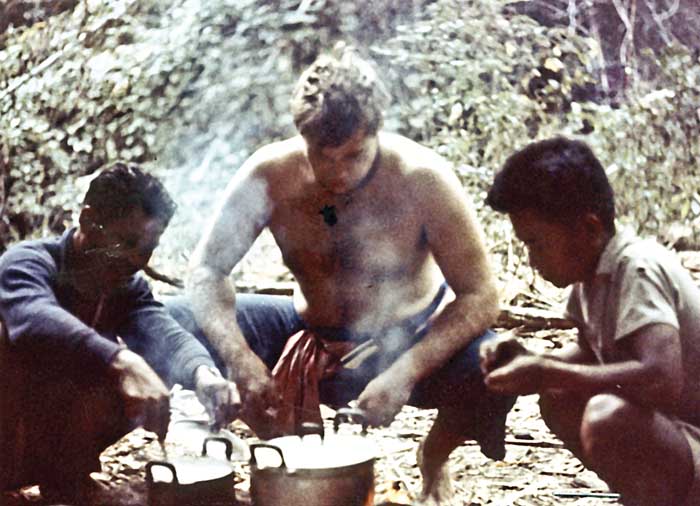
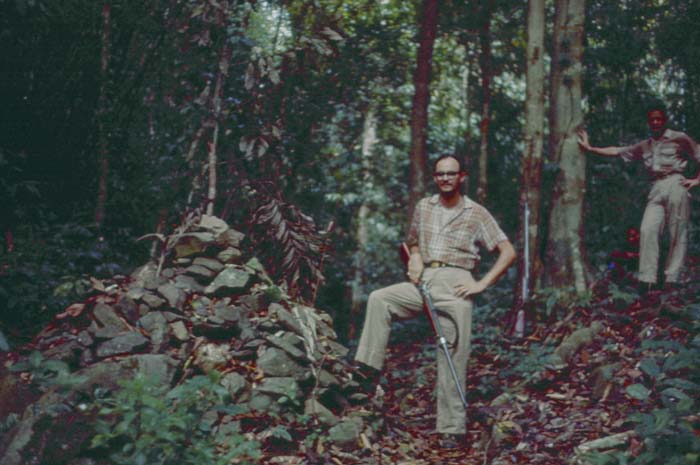
SAR: Did you see any modern military weapons or any unusual antique machine guns or anything while you were in Thailand?
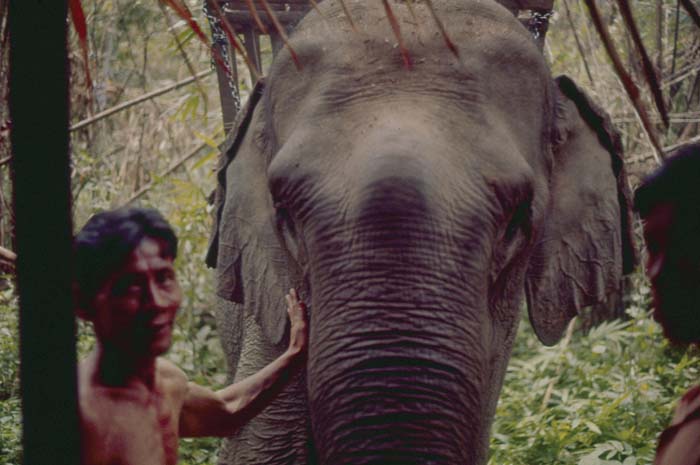
Dave: Not in private hands. Remember, I spent three years working the surplus arms deals there for Sam Cummings. One of the museums in Bangkok, it’s part of a temple, had something I’d never seen anywhere. It was a Model 76 Winchester in a full-length case, highly engraved and gold-plated, with 50 cartridges, a loading tool that’s gold-plated and all the goodies. Very fancy wood. There’s a plaque on the lid of the box that says something like, “Presented to His Royal Highness,” and then all his titles and “for assistance to the United States.” There was a big hurricane they had, or a typhoon. It washed a US Navy ship ashore and the Thais helped out. That’s about the time that Perry was over there, I think, and it was commemorated later. They presented this rifle from the President of the United States, and I’ve never seen that written up in any book at all. This museum also had a 1″ bore solid bronze, including the barrel, pinfire revolving cannon. Now that’s something to see. The hammer is a dragon’s mouth and it comes out, and the cylinder is about a foot and a half around.
SAR: Any other exotic hunts?
Dave: On that hunt where we were ambushed, about the second day out, we split up into three groups. The other Thai guy who was hunting with us came running into camp and he’s screaming, “Ngoo Yai, Ngoo Yai,” which means “big snake” in Thai. I grabbed a double-barrel 12 gauge and put in some #4 buckshot and we ran up there where this “big snake” was. We got up where there was a little savanna of maybe 100 yards, 150 yards diameter. It was full of grass that was about two and a half feet tall, about knee-high. He worked hard to make me understand that there was a snake in there, that it was a big one, and that it would come after me if we went in. I smiled and said, “Yeah, go ahead and do what you want to do.” I got ready and I was looking around everywhere I could see for the bush to move for where that snake was going to be. Cobras, incidentally, are vindictive. They will defend territory. The guide cut a piece of bamboo that was about 12 or 15 feet long. It was pretty skinny and he trimmed all the leaves off the top except at the very end of it. He left a little bunch of leaves up there. Then he got alongside and a bit to the back of me and he indicated that I should walk along with him just to his right. He was going to sweep the grass with this piece of bamboo and I was going to shoot the snake. Well, we were just going to see how well this works out. [laughter] So, at any rate, we were walking along in there and I got in there about 30 seconds into the grass when I heard what was like a bottle of gas going, “Ssssssss,” a hissing noise. That damn snake came up out of the grass about four feet high and looked me right square in the eyeball. That just scared the shit out of me. [laughter] I had no idea, I mean NO idea, how big a King Cobra could get. I pulled both triggers and turned around and ran for my life. When I got out to where I could see if that snake was going to follow me or not, I was reloading the shotgun in a hurry. I looked around for my assistant and he was over there with his big knife, chopping. He finished the snake off with that knife. I just blew some of the head off and he chopped the rest of it. That was more than a little exciting. We brought it back to camp and skinned it out, but none of us knew anything about what we were doing and we didn’t preserve it properly. Unfortunately, I lost the trophy. That was a six meter King Cobra, over 19 feet long. I think the record on Kings is 22 feet long.
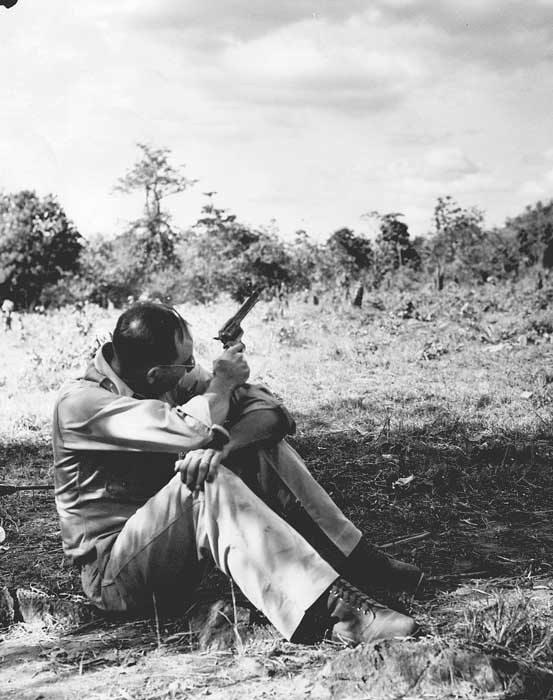
SAR: That’s an incredible snake, too bad you didn’t get the trophy.
Dave: In those days, it would have made quite a stir. As far as firearms go, I did make a trade with my Thai friend and one of the gunsmiths that had never been out of Bangkok. They’re all on one street, Boorapa Road. I’d been there enough that they all knew me after six months or so. This guy said, “I want you to take a look at this combination gun I’ve got. I can’t get any ammunition for it.” I looked at it and he brought out a combination double rifle Drilling. It was 9x57mm rimmed for the rifle barrels and 24 gauge on the shotgun barrel. The interesting thing about it, I’ve never seen this since, it had selective automatic ejectors on it which is very unusual on a Drilling. On the little ejectors themselves, they have a slot cut in there and a spring-loaded tooth so that you can put the smallest cartridges in there. The spring would depress as they went down. If the cartridges went in, the bottom of the case would depress the spring and then, when it got to the end, it would snap into the extraction groove of the cartridge. It worked just great. I bought some 500-grain soft-point bullets for another gun, for my Sharps. I kept looking at the Drilling, and 245-grain soft-point bullets I could get there, and I had a friend in the states who didn’t mind taking a few chances. Later, he got a few pounds of powder and mailed it to me along with primers and I made up the ammunition. It worked just fine. Anyway, I had to have this gun so I said, “What do you want for this?” He said, “I don’t want to sell it, I want to trade it to you. I want one of those new .44 magnum carbines because I just can’t get them over here.” I ordered one through the PX, and sure enough, it came through and I did the trade. After I had it about six months, I told the colonel in charge that carbine was going to be shipped back to the states and I gave it to this guy instead and took his Drilling. I had a Dutch friend who lived where the Bridge on the River Kwai was. We went hunting down in that same area where there’s an abandoned railroad track in the jungle and they keep just enough debris off of it to where you can take a section car and make it out over to these little jungle villages. Our host down there was a Dutchman, about 85 years old, named Captain Charles Brie Dubrow. I’ll never forget it. He gave us this treat of gin while we were there, warm gin, which is bad news. The Captain was just getting married for the second time. “That’s nice,” I said, “Did you have to get married?” He said, “No, I wanted to get married.” I was joking around with him and asked if he had any kids. He reflected and said, “No, not yet, but there’s one coming.” I laughed and said “You’re quite a man.” He said, “Actually, when I was looking for a woman, I got this matchmaker to look for a woman for me and the matchmaker said, “The only thing wrong with her is that she’s just a little bit pregnant.” [laughter] The Captain says, “My friend, at 100 meters you could tell she was a little bit pregnant. But at my age I don’t care, I liked what people might think!”
SAR: It’s 1959 and you were in Bangkok.
Dave: Yeah. The Vietnam War was starting to heat up a little bit. I met Sam Cummings in Bangkok, the president of Interarmco. He made me an offer to work for him as a moonlighter. He was in the Air Wong hotel which was the best hotel in town at that time. He was on an around-the-world trip for his honeymoon. He came by our little apartment and, in addition to helping out, he said, “The general said that you know about antique guns.” I said I did, and he started asking about what I had seen in Thailand. There were a lot of cannon there and he ended up getting all the cannon. They had a couple of beautiful Gatling Guns. There’s a museum there today, the Royal Thai Army Museum in Honour of HM The King, that’s never been opened to the public, and they have a lot of these beautiful guns on display there. Anyway, Sam made me a deal to act as a representative to buy and sell for him and Interarmco. It was 10% of whatever I did, and a monthly paycheck of $600. I was still holding military ID which got me into any of the places I needed to get into. The Immigration Department was looking for me of course. My wife had gone home already when her visa ran out. They knew where she was, but for some reason, they couldn’t find me. We had two children born over there, by the way. When they finally did find me, they said, “You’re going to have to leave.” I had a lot of stuff that I didn’t really want them to look at because it was illegal in most cases. I got a hold of my friend, Boon-aek. He was the Chinese pawn shop owner. Boon-aek said, “Don’t worry. I’ll take care of things.” On the day I had to leave, I had my passport, my ticket on the MATS flight, but I had to go through entire Thai Customs to get on the MATS flight. This Cadillac limousine pulls up out in front of my apartment. My friend was in there, with the Colonel who was the head of the Thai Arsenal. We got out at the airport and I gave him my suitcases and passport, as I was told. He said, “Get in the car,” and we drove out over the blacktop to the plane. They shook my hand, and I got on the plane and I asked where my passport and baggage was, and he said, “It’ll be right behind you.” And it was. He got me out of the country without any trouble.
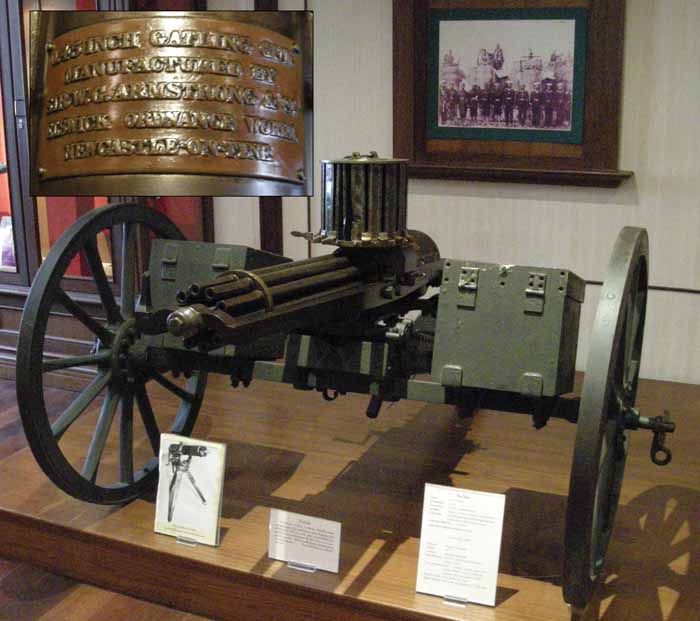
SAR: What was the stuff that you had that wasn’t legal?
Dave: That combination Drilling was one thing because it hadn’t been properly registered, no papers been filled out on it. I didn’t have any proof of owning it, and even at that time in Thailand that was trouble. Oh, yeah, and I had a statue of Buddha about 18″ tall. It was an old one from Ayutthaya from about the year 1350.
SAR: Just happened to have a statue of the Buddha in your suitcase?
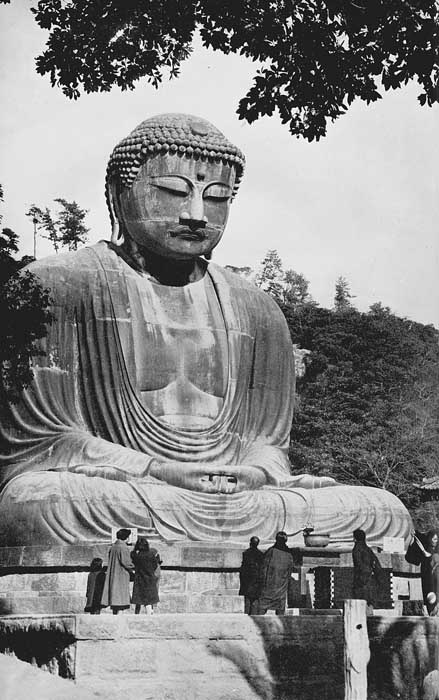
Dave: (Laughs) Yeah, guess that sounds out of context. Religious items like that were definitely not to be taken out of the country, even back then. A friend of mine, he had purchased this thing for $30,000 in cash from a dealer in upcountry Thailand, in the name of the Cincinnati Museum of Art. I was just the one that was supposed to smuggle it out of the country. I had it wrapped up in a towel in my suitcase. When I got to Pearl Harbor, the customs guy asked if I had anything to declare. I said, “Nothing except I got a rifle here that I neglected to have signed up before I went out of the country.” He said, “Well, you can fill this form out and swear that it was yours, then that’s okay.” I said, “I’ve got this other thing here in the towel.” He said, “What’s that worth?” I said, “Oh, maybe $30,000 or so.” He decided to impound that on the spot. I couldn’t have that happen since I’d promised to bring it, so I started in on how this was important, for the museum, and if there was so much as a scratch on it his ass would be in such a bind. He started getting nervous, and even though it was 3 o’clock in the morning in Cincinnati, Ohio at that time, he called up the director of the museum, got him out of bed and finally he hung up and he said, “It’s yours. Take it with you and get moving.” I had a couple of pistols, a baby Nambu, a Papa Nambu, and one of the palm firing “squeeze” pistols.
SAR: How long were you working for Sam Cummings in Thailand?
Dave: About two years. I didn’t come back to the states at all during that time. Found a lot of great stuff. There was a bunch of the little 50mm Krupp guns like Dolf Goldsmith purchased from us. They were beautiful little guns, and I still have one, it’s serial number 1. We found about 25 small cannon, one of which was very unusual. It was English and it was a breech-loader. It had two barrels, side by side. The breech block had a handle. You pulled the handle up and it rotated. Then the breech block pivoted out to the right side from one barrel, and the other pivoted out to the left side. It took a bag of powder with a ball in it and loaded from the breech end and fired with two percussion fuzes. It was very unusual. We got the cannon back to the States. Actually, Tom Nelson was in charge of that deal after I left. I’d been in business in California about a year and a half by that time. He called me up one day and he says, “You got any money?” I said, “Yeah.” He said, “You want to buy some cannon? The Thai stuff’s coming in.” I said, “Hell, yes I do!” I never did know who actually finalized those deals, whether Tom did it or somebody else did it. I never asked him, but I bought some cannon. There were Gatling guns and a couple of Nepalese Bira guns. Those look like big, ugly, pan-fed Gardeners. We were not interested in those, so we didn’t buy them but we bought all the rest of the cannon including the little bronze rifle breech-loading pieces. Really, these little guns were about the size of a two-pound Hotchkiss gun. We had some two-pound Hotchkiss guns, no wheels. We had to have wheels made. There ended up being about 35 of the little Krupp guns. There were quite a few thousand 8x50R caliber rifles that were made on a contract by the Imperial Arsenal in Koishakawa, Tokyo. It was a 98 Mauser bolt-action style, and an excellent rifle, sometimes called the “Siamese Mausers” or the “Type 45.”
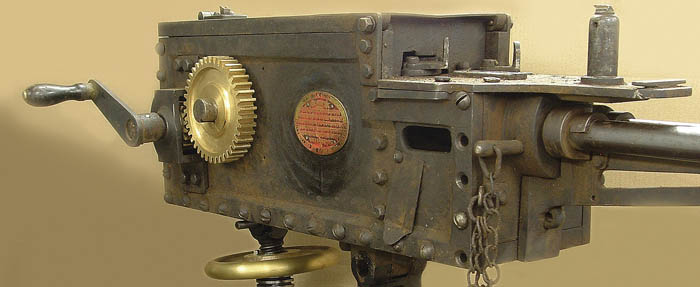
SAR: You did the Armalite AR-10 project to the Thai government for Sam.
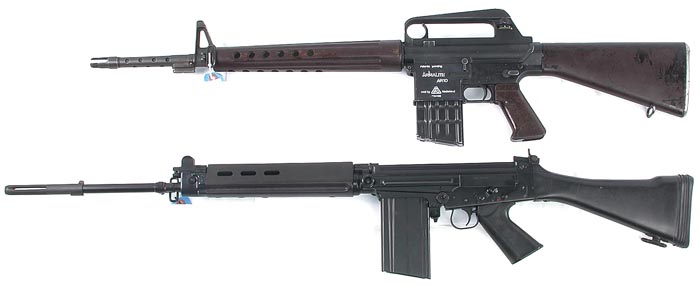
Dave: I got a letter from Sam which said, “We have information that leads us to believe that the Thais are going to have a weapons testing with the FAL. We would like to compete with the AR-10. Would you like to get into this?” As usual I said, “Hell, Yeah!” Sam said he’d make me a good deal if I could pull this off. The test was on a Saturday afternoon. I think it was 1959 or ’60. Interarmco sold me an AR-10. There was no trouble to get it. They just simply mailed it to me through the U.S. mail, and it came in by military mail at the G.I. Post Office in Bangkok. I had the gun, two magazines and a bayonet. It was an Artillerie Inrichtingen, an AI Dutch gun. A nice rifle, it had a wooden forend instead of plastic, and the bayonet had a combination tool like a Swiss Army knife built into the handle. That is what people call the “Sudanese AR-10” today. I went out to this test with this AR-10 that I didn’t know much about. I wrote in to the Thai government and I got permission to bring the gun, and they were very lackadaisical about the fact that I had a machine gun. I guess they figured, if he’s got it, it must be legal. They fired the FAL, which is a nice rifle as well. While the FAL shoots well, that AR-10 is a helluva lot more controllable with off-hand fire in particular. I had a Lyman bullet puller, and a hand-seating tool in .308. I pulled five rounds of the ammunition in .308 and dumped the powder out on the counter. I took a knife and just slipped half of the powder off on the floor. I did the same thing with about 20 rounds for the FAL. The FAL malfunctioned three times and my AR-10 didn’t malfunction at all. I did that right in front of the Thais, showed them that even if there was an inconsistency in the powder, the AR-10 would still function. Their response was positive. I was working with the Minister of Defense. The first thing he did was to put his hand on my shoulder and say, “I hope we can do business.” And I was thinking “My money’s made.” He then asked “How much money do I get out of this deal?” I negotiated with him, and he was supposed to get about 11/2 or 2% commission. There was another guy in the Ministry of Defense and he was supposed to get $25,000 US. Right as we were finalizing, I got this letter from Sam that said, “Discontinue AR-10 deal. Lost the manufacturing rights with the Dutch.” That was the end of that. There were about 10,000 AR-10s in the deal, at about $160 USD each. By the time it was all added up, it was about $7 million including the cost of the guns, ammunition, armorer kits, spare magazines and bayonets. I never did find out what the whole deal was; I figured it wasn’t my place to ask. Gene Stoner never came over while I was there on the AR-10 project.
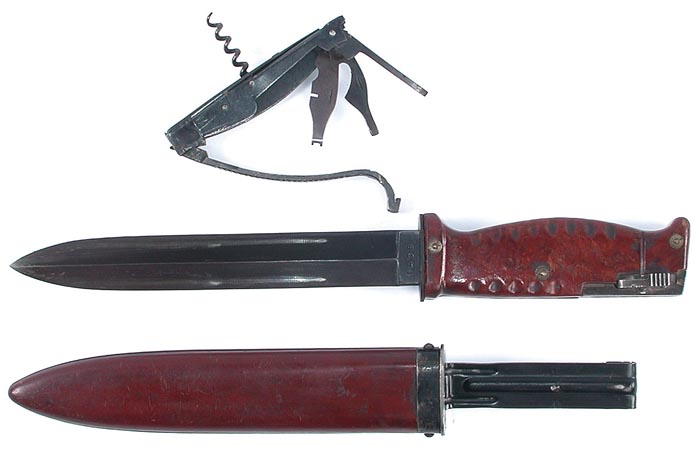
SAR: Any other experience with assault weapons or machine guns in Thailand?
Dave: No, but I did learn how to charge the cylinder on a Pack 75 Howitzer. The Thais had a couple of those. They loved the older guns and they had a pile of ammunition for them, too but they never fired the Pack. I was watching this Thai working on this gun and I asked what he was doing. He spoke pretty good English and he said, “We’re trying to get the gas recuperative system charged up from the nitrogen bottle, but we don’t really understand what the terminology is.” I took the manual home and read it that night. The next morning I said, “Let’s put this thing together.” I said, “But we have to test fire it after we get through to make sure it works.” He said, “Well, of course.” So we fired about five rounds down the road and it worked just fine. The Pack 75mm is a neat little gun. They had a very interesting gun in the Thai Arsenal in Bangkok. It was an open-tracked vehicle very similar to a Scorpion, with an anti-tank gun, basically a tracked armored vehicle with a freestanding gun. It looked to me like a new German 88 mounted on there but it could have been something else. Sitting next to it, the most interesting cannon I’ve ever seen, was a pair of Bofors artillery pieces. They were over and under barrels. These were fed by hand. The Thais had a lot of neat cannon.
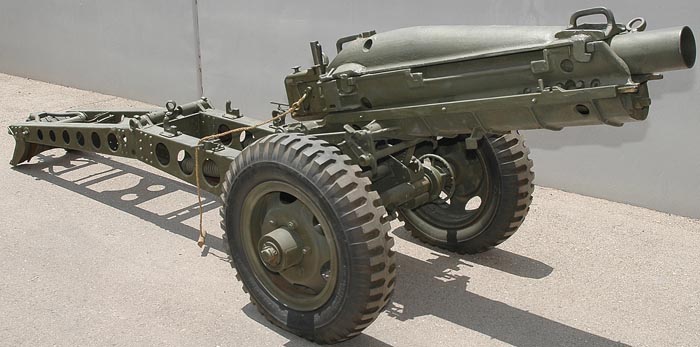
SAR: When you came back to the US, you got you involved in the regular firearms business?
Dave: I always wanted to be in the gun business, and that all started well before Thailand. I was in Mare Island Shipyard, and the ship was in for repairs. My wife-to-be was there, in nursing school. I’d known her before in college at the University of Virginia. I found out where she was and we dated and ended up getting married after two or three months. I was down at Mare Island one time, I’d been there about a week, I guess. I was taking the bus and I looked out the window and here’s this sign, the Old West Gun Room, a gun store. I pulled the chain on the bus and got off. I looked at the store, and made friends with the people in there. After a short time, I said, “George, if you ever want to sell this business and I’m in a position to buy it, I’d like to know.” That was the Old West Gun Room, in El Cerrito, California, which had started in 1952. George Repaire, the owner, was a Colt collector extraordinaire. He had bought the Sultan of Turkey’s Dragoon. It was the most elaborate, privately owned, engraved Colt in existence. The only other one was in the Hermitage in Russia. Actually, they were both supposed to go to the Czar as a pair but Colt needed to make points with the Turks so he gave the Sultan of Turkey one of the two guns they’d made for the Czar. Colt encased them both in very fancy cases, the whole ball of wax. Some years later he donated that Dragoon to the Metropolitan Museum of Art in New York City. He had turned down a $5 million price on the gun. It was 1955 when I first went into the Old West Gun Room, and I was hooked.
SAR: Did he have machine guns?
Dave: He had an old Colt Potato Digger with the leather case, and a Maxim MG08 on a sled mount. George had some old submachine guns, but everything was a Dewat. Those “Deactivated War Trophies” didn’t have to be registered at that time, that didn’t start until 1968 of course. I met George Repaire before I went to Thailand. When I was coming back, he wrote me a letter and he said, “My health is bad. I’ve got to move to Arizona. If you want the business, I’ll sell it to you for $10,000 down and the balance as sold. The $10,000 was for the goodwill and then he consigned a lot of guns to me to help me out. The Old West Gun Room had started in 1952, I got it in 1961, and as we’re talking today it’s still in business, being owned by my former manager Bob. Aside from the fact that we were living on cash flow, things were pretty good. Everybody thinks that it’s all big money in the gun business, but lots of times it’s hand-to-mouth for anybody with a gun shop. It was tough. The only thing that saved us was the building that the gun store was in; it was an old grocery store from about 1910. It was about 50 feet wide and about 25 feet deep, with a 12 foot tin ceiling. The three bedroom apartment attached to and behind the building was where we lived. If it hadn’t been for that I’d never been home because I stayed open until 8:00 o’clock at night. If I went to work I just opened the door in the wall and walked through and there I was in the gun shop. I sold that gun shop in 1984.

SAR: Did you start getting involved in the unusual firearms right away?

Dave: Of course! I went back east and my father-in-law gave us a ’52 Buick four-holed wagon. It had the four holes in the side of the fender. I put a rental trailer on it and went down to Interarmco and I bought a 25mm Hotchkiss, a 25mm Puteaux anti-tank gun and two cans of ammunition for each gun. There were eight rounds in the can. I put them in that trailer and then we put in mattresses and the furniture that her parents had given us and anything else we could get in. I took off and it took me a week to drive across the United States. Drove across on 80. I can’t remember the name of the damn mountain over here, the one right by Lake Tahoe. Coming down on the California side, the brakes started to go out on that old Buick. I told my nephew, “If I say ‘jump’, you open up the door and jump out into the ditch and I’ll put this thing up against the rocky wall and scrape it to a stop.” I did manage to get the rig stopped, but then it wouldn’t start up again. It was overheated. We finally managed to make it but we were worn right out. Then I didn’t have enough money to bring Elsie out so it was another month and a half before she could join me.
SAR: Did you shoot those 25mms right away?

Dave: No, I was having fun but doing business. There were two brothers that came in to the Gun Room. One was about 18; the other was about 21. They decided they had to have one of these 25mm cannon. Those guns were selling at Interarmco for $50 a piece. They were retailing them for $139 or something to that effect. I put $199 on them. These brothers decided that they had to have it so I sold them the gun for $199 and I sold them a can of ammunition for $2 a round, and I showed them how to work it. About a week later, I get a call from the Richmond Police Department. “Did you sell Joe and Bob Smith a cannon?” I answered that I had. “Well, where is it?” I said, “Hell, I don’t know. They probably got it. Go ask them.” They said, “We can’t find them.” I said, “Well, I’ll give you their address, at least the one that they gave me when they bought the gun.” So, I looked it up on the 4473 and the police headed out to find them. Turns out what these two had done is they’d gone down on Point Richmond where there used to be an old pistol range on top of a hill right by the old Kaiser Shipyards. That’s where the guards used to practice. They drive up there one Sunday on the top of this hill. You can’t see them from the bottom. There’s an island out there off the Richmond Bay Bridge, the bridge up in Marin County that crosses the bay. This island is called Red Rock because there’s a red rock sticking about 150 feet straight up, just a big knob right there in the middle of the bay. It’s about 1/4 mile from the bridge. These turkeys were firing at this little island out there. [laughter] The cops come up there and they said, “What are you doing?” They said, “Oh, we’re having a little target practice, officer.” “You can’t shoot a cannon here.” One of the brothers says, “Well, why not?” The cop told him “You just can’t.” “Is there any law against it?” And the cop scratches his head, he says, “I don’t think so but I’m just saying you can’t do it. It’s not safe.” That was a pretty crazy thing for them to be doing but at the time, Destructive Devices didn’t exist. It was just a firearm like any other, and they were just out target shooting.
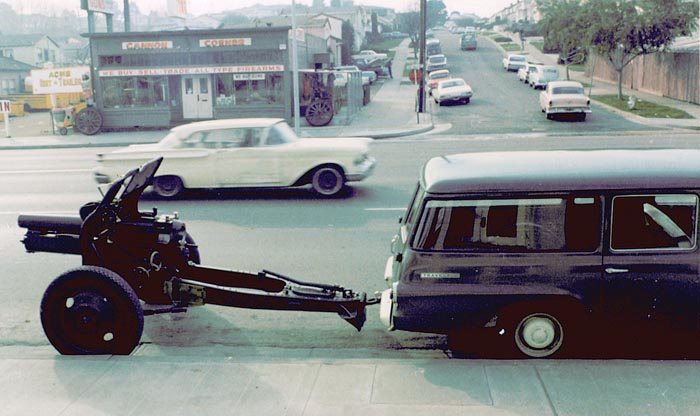
SAR: Did you start getting any machine guns in or start doing any work with the movie industry?
Dave: Oh yeah, a lot. We moved into another location about 100 yards up the street. It was an old nursery, with a nice concrete building. By that time, Elsie and I had saved enough money where we could buy a home out in Pinole. We moved the business up there and started looking around. Just before we moved into the new place, I met Bert Jacques. He came into the store one day. He had this International Travel-All, with a special trailer made up for it that had hydraulic brakes that connected to the hydraulic brakes with slave pistons on his car. He could adjust the trailer so if he had a lot of weight in the trailer he could put more braking power on this. It worked pretty well, actually. He would go back to Interarmco and would buy a million rounds of beautiful 9mm ammo. I can’t remember who made it but it was gorgeous stuff. Interarmco had purchased several million rounds of the brass and they had it loaded. It was 2 cents a round in bulk. Bert would get his trailer loaded with this ammo. He’d start on the East Coast and he would sell ammunition as he proceeded to the West Coast and he’d just buy and sell as he went. By the time he got to the West Coast, he’d turn around and drive back and do it again. He came in the Gun Room and said, “You ain’t doing anything in machine guns?” I said, “Nope, never really thought about it.” I got to know him pretty well after a while. I had another friend whose name was Tom Phair and another friend by the name of Hal Ross. All these guys, we were all looking to go in together and get something but none of us had any money. We decided we would get together and we would call ourselves the OSS, Order and Supply Service. That we did and the first thing we got into was when Bert went up to somewhere in Sacramento. We had six Winchester BARs, World War I, high-polished finish – they were original Model of 1918 BARs. Semi- or fully automatic, just beautiful guns. We paid about $200 a piece for them. Bert said, “I think I can get about $450.” We said, “Boy, now that’s a good deal.” We were turning the money around for a fast profit. We kept on doing it. One day we got a phone call from a guy in Canada that Bert knew. He said, “We’ve got a Maxim machine gun up here that you might want to buy. It’s one of the guns that the U.S. Army used in the trials. It’s a .45-70.” I didn’t know anything about this because I’m not a machine gun addict. Bert on the other hand, said that we better go take a look at it. We bought a ticket and shipped him off to Montreal. The guy wanted about $2,500 for it. He had the tripod and some belts and miscellaneous odds and ends. It was in really nice shape but we didn’t buy it because we decided that it was too much money. A week or ten days later, I was having dinner with Bert down at a local restaurant. I looked at Bert and I said, “Bert, you know what I was thinking?” He said, “Yeah, I bet I was thinking the same thing you were thinking. We should have bought that goddamn gun.” I said, “Yeah, you’re right.” I said, “Do you know if it’s right or has it been put together?” He says, “I don’t know.” I said, “I don’t know either but one way or another, we ought to find out about it.” The next day, Bert called the guy up and he had sold it. As I recall, they made two of those.
SAR: Wish I knew where that was now.
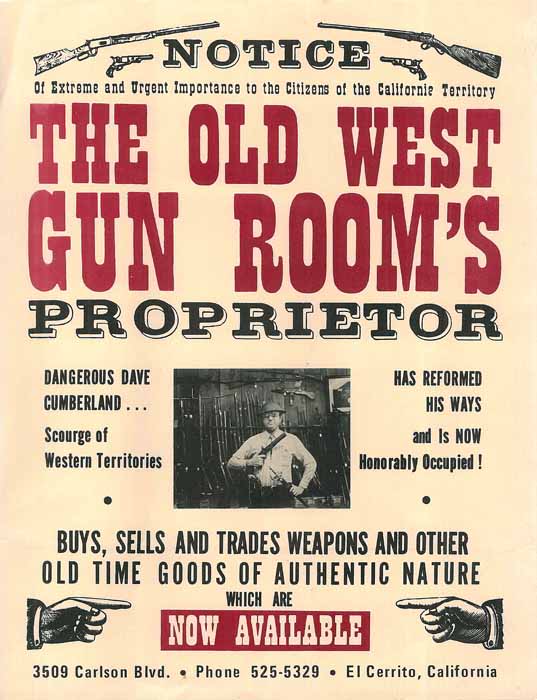
Dave: We had a pile of machine guns go through the shop, but that was definitely “The one that got away.” We sold those BARs, and I got in a Potato Digger and they de-milled it by welding the barrel at the muzzle. We sawed a 1/2 inch off the muzzle, loaded it up and it worked like a charm. [laughs] We shot the heck out of it, then we welded it back up again and ended up selling it to a collector. That was when Dewats didn’t have to be registered, but people would activate them and de-act them pretty much at will.
SAR: When did you run into Dolf Goldsmith?
Dave: Now, that’s a whole story on its own…
Join us in Part II of the Dave Cumberland Interview in the next issue of SAR. Dave talks about the deals with Dolf, the Thorensen Affair, doing business in the Sixties, the movie gun deals, “The Old Western Scrounger,” Gardner guns, the Rock Crusher press and much more!
| This article first appeared in Small Arms Review V12N11 (August 2009) |











